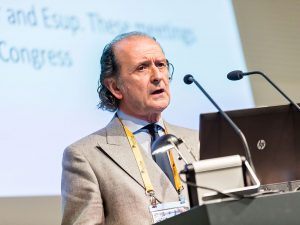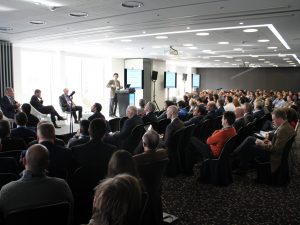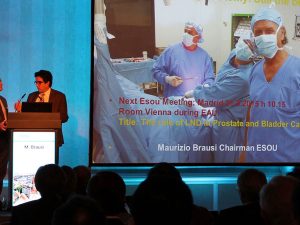Prostate cancer was the leading topic in the morning session of the first day of ESOU17, the 14th Meeting of the EAU Section of Oncological Urology. The meeting is taking place in Barcelona over the course of the next three days, 20-22 January 2017.
Due to a change of plan after last year’s meeting, Prof. Paolo Gontero of Turin, Italy found himself in the unusual position of being ‘local’ organizer in a city in another country. He joined Profs. Joan Palou (Barcelona, ES) and Maurizio Brausi (Modena, IT) in the setting up of a three-day scientific programme, focused on offering urologists an update on uro-oncology.
A unique meeting Prof. Gontero called ESOU “peculiar” in his welcome to the 900 delegates, referring to the qualities that sets it apart from other (uro-) oncological meetings. “I don’t think you’ll find a similar programme at the same high standard. EMUC would be the closest thing, but that meeting is designed to improve current knowledge, with oncologists and radiologists also on the organising board. ESOU is much more geared toward the needs of the urologist who deals with oncology as part of the daily clinical practice. We offer an update on the latest research and developments.”
Nevertheless, ESOU17 features speakers with many different backgrounds, including doctors who specialized in basic science and radiologists who offer their own viewpoints. “Nowadays, basic science is moving into practice, as we heard Chris Evans explain this morning. As a urologist, you need to know about genomics. And it’s precisely by covering topics like this that ESOU is a success.”
The morning also saw a debate of sorts, with Profs. Djavan, Barentsz and Briganti discussing the “acceptable standard” for prostate biopsy in 2017. Prof. Barentsz’s “Yes we scan”-mentality contrasted with talks of “making TRUS great again”. When Prof. Evans announced that he was happy to present, as he was looking forward to not having to discuss current events for fifteen minutes, it was clear that the divisive inauguration that was taking place elsewhere was also on the minds of the speakers.
Prof. Gontero summarized the discussion as follows: “Multidisciplinarity traditionally referred to treatment, but now it’s also the case for diagnosis. As urologists, we cooperate closely with radiologists, and the radiologist can take over part of your clinical job by not only doing prostate MRI but also biopsy. Close integration and cooperation is essential, or you see the clinical job going to another discipline and subsequently a possible drop in the quality of treatment. We need to develop a common language and keep talking.”
“In the past two or three years, the radiological world might have been overenthusiastic about achievements, whereas the urologists were perhaps a bit more reserved. Now we can acknowledge the progress, but also point out where improvement in diagnostics still needs to be made.”
ESU and STEPS
With Prof. Palou as a local organizer, there is also a strong ESU presence at the ESOU meeting this year. A three-hour ESU Course will be offered, strongly case-based on the complication and management of patients undergoing cystectomy.
Gontero: “It’s useful, and a privilege for us that Prof. Palou is also ESU Chairman. It’s a clever idea to devote Saturday afternoon to a course that is highly practical. Cystectomy is routine operation for urologists, but in clinical practice it has major impact in terms of complications. It is completely in line with idea of the whole meeting to have this kind of course, which will be more case-based than typical ESU courses.”
The ESU Course is taking place at the same time as the invitation-only STEPS programme. Led by Prof. Brausi, the “Session To Evaluate ProgresS” has been a recurring event at the ESOU meetings since 2011. Twenty young clinicians are invited each year to meet international experts and discuss topics like prostate, bladder, renal and testis cancer. The advantage of the small, closed group is the high level of interaction that is possible between participants and experts.





